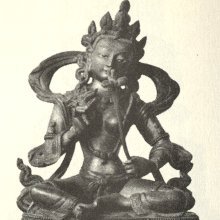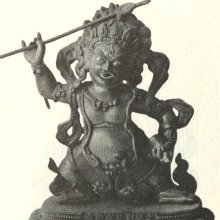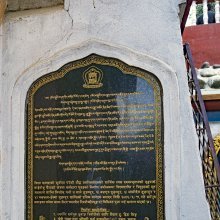Ling, Liṅg: 8 definitions
Introduction:
Ling means something in Hinduism, Sanskrit, Hindi, biology. If you want to know the exact meaning, history, etymology or English translation of this term then check out the descriptions on this page. Add your comment or reference to a book if you want to contribute to this summary article.
Images (photo gallery)
Biology (plants and animals)
Source: Google Books: CRC World Dictionary (Regional names)1) Ling in China is the name of a plant defined with Trapa bispinosa in various botanical sources. This page contains potential references in Ayurveda, modern medicine, and other folk traditions or local practices It has the synonym Trapa bicornis Osbeck var. bispinosa (Roxb.) Nakano (among others).
2) Ling is also identified with Trapa natans It has the synonym Trapa bicornis Osbeck (etc.).
Example references for further research on medicinal uses or toxicity (see latin names for full list):
· Flora URSS (1949)
· Dagbok ofwer en Ostindisk Resa (1757)
· Journal of Japanese Botany (1942)
· Journal of Wuhan Botanical Research (1985)
· Botanical Magazine (1897)
· Hortus Bengalensis, or ‘a Catalogue of the Plants Growing in the Hounourable East India Company's Botanical Garden at Calcutta’ (1814)
If you are looking for specific details regarding Ling, for example diet and recipes, side effects, extract dosage, pregnancy safety, chemical composition, health benefits, have a look at these references.

This sections includes definitions from the five kingdoms of living things: Animals, Plants, Fungi, Protists and Monera. It will include both the official binomial nomenclature (scientific names usually in Latin) as well as regional spellings and variants.
Languages of India and abroad
Sanskrit dictionary
Source: DDSA: The practical Sanskrit-English dictionaryLiṅg (लिङ्ग्).—I. 1 P. (liṅgati, liṅgita) To go, move. -II. 1 U, (liṅgayati-te)
1) To paint, variegate.
2) To inflect (a noun) according to its gender.
Source: Cologne Digital Sanskrit Dictionaries: Benfey Sanskrit-English DictionaryLiṅg (लिङ्ग्).—i. 1, [Parasmaipada.] † To go. i. 10 (rather a [denominative.] derived from liṅga), [Parasmaipada.] To change a noun according to its gender.
— With the prep. ā ā, i. 1, [Parasmaipada.] (in epic poetry also [Ātmanepada.], [Rāmāyaṇa] 2, 64, 30), and i. 10. To embrace, [Vikramorvaśī, (ed. Bollensen.)] 71, 118 [Mṛcchakaṭikā, (ed. Stenzler.)] 91, 14; [Pañcatantra] 187, 6 (i. 10); [Kathāsaritsāgara, (ed. Brockhaus.)] 3, 65 (pf. red. liliṅga). Ptcple. of the fut. pass. āliṅgya, n. A small drum, [Rāmāyaṇa] 5, 13, 47.
— With pratyā prati-a, i. 1, To return an embrace, [Mṛcchakaṭikā, (ed. Stenzler.)] 91, 15.
— With samā sam-ā, i. 1, 1. To embrace, [Pañcatantra] 27, 6; [Mṛcchakaṭikā, (ed. Stenzler.)] 91, 13. 2. To hold, [Rāmāyaṇa] 5, 13, 48; 53.
— Cf. probably [Old High German.] and [Anglo-Saxon.] hring; [Old High German.] bringjan.
Source: Cologne Digital Sanskrit Dictionaries: Cappeller Sanskrit-English DictionaryLiṅg (लिङ्ग्).—v. āliṅg.
Source: Cologne Digital Sanskrit Dictionaries: Monier-Williams Sanskrit-English DictionaryLiṅg (लिङ्ग्):—(cf. ā- √liṅg) [class] 1. [Parasmaipada] liṅgati, to go, [Dhātupāṭha v, 48];
— [class] 10. [Parasmaipada] liṅgayati, to paint, variegate (citrī-karaṇe), [ib. xxxiii, 65];
—to change or inflect a noun according to its gender, [Vopadeva [Scholiast or Commentator]]
[Sanskrit to German]
Sanskrit, also spelled संस्कृतम् (saṃskṛtam), is an ancient language of India commonly seen as the grandmother of the Indo-European language family (even English!). Closely allied with Prakrit and Pali, Sanskrit is more exhaustive in both grammar and terms and has the most extensive collection of literature in the world, greatly surpassing its sister-languages Greek and Latin.
Hindi dictionary
Source: DDSA: A practical Hindi-English dictionaryLing in Hindi refers in English to:—(nm) male genital organ, penis, phallus; the phallus deity representing Lord Shiv; gender (in Grammar); sex; -[upasana] phallus worship; phallicism; —[aura vacana] gender and number (in Grammar); -[deha/sharira] the ethereal form of corporeal body (that is supposed to accompany the soul to face the consequences of one’s worldly deeds); ~[pujaka] a phallus-worshipper; phallicist; ~[puja] phallus-worship, phallicism; -[dosha] a mistake of gender; —[pratishtha] installation of the phallus-deity..—ling (लिंग) is alternatively transliterated as Liṃga.
...
See also (Relevant definitions)
Starts with (+265): Limgadaha, Limgadehi, Limgadharaka, Limgadharane, Limgadhari, Limgadikshe, Limgadura, Limgaikya, Limgamenasu, Limgamudre, Limganu, Limgapatha, Limgaroga, Limgarpita, Limgasaraya, Limgashariri, Limgasthala, Limgasvayata, Limgatanu, Limgatatva.
Ends with (+114): Aling, Angsana keling, Ao mai ma dou ling, Apaling, Assembling, Banpaling, Batikoling, Batikuling, Buluh suling, Cadling, Calling, Chawng-hling, Chharling, Chickling vetchling, Common spiderling, Common vetchling, Creeping spiderling, Dao di ling, Darjeeling, Dealing.
Full-text (+272): Alinga, Alingana, Artemisia conaensis, Ling ling hsiang, Ratneshvara, Alingati, Sonkadi, Tu fu ling, Chhoti surajmukhi, Tieh ling chio, Xuan ling mu, Viparita-linga-akarshayama-naritattva, Ling lan, Bansirsa, Ling-pring, Lingopadamsha, Ou ling, Ling chio, Onrka-phula-ba, Ma dou ling.
Relevant text
Search found 46 books and stories containing Ling, Liṅg; (plurals include: Lings, Liṅgs). You can also click to the full overview containing English textual excerpts. Below are direct links for the most relevant articles:
Bharadvaja-srauta-sutra (by C. G. Kashikar)
Brahma Sutras (Nimbarka commentary) (by Roma Bose)
Brahma-Sūtra 2.3.15 < [Adhikaraṇa 6 - Sūtra 15]
The travels of Fa-Hian (400 A.D.) (by Samuel Beal)
Tiruvaymoli (Thiruvaimozhi): English translation (by S. Satyamurthi Ayyangar)
Pasuram 4.10.7 < [Section 10 - Tenth Tiruvaymoli (Onrum-tevum, ulakum)]
Pasuram 8.3.2 < [Section 3 - Third Tiruvaymoli (Ankum inkum)]
Buddhist records of the Western world (Xuanzang) (by Samuel Beal)
Chapter 5 - Country of Hwoh (Kunduz) < [Book XII - Twenty-two Countries]
Chapter 23 - Country of Kho-to-lo (Khotl) < [Book I - Thirty-Four Countries]
Chapter 18 - Country of K’ie-p’an-t’o (Khabandha or Khavandha) < [Book XII - Twenty-two Countries]
Blue Annals (deb-ther sngon-po) (by George N. Roerich)
Chapter 29 - Sonam Gyatso (viii): Paranirvāṇa < [Book 10 - The Kālacakra]
Chapter 12 - Teurapa (rte'u ra pa'i skabs) < [Book 14 - Great Compassion Cycle]
Chapter 8 - Second incarnation series (viii): zhwa dmar cod pan 'dzin pa < [Book 8 - The famous Dakpo Kagyü (traditions)]


